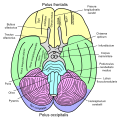| Uncus | |
|---|---|
 Medial surface of left cerebral hemisphere. Uncus is shown in orange. | |
 Human brain inferior-medial view (Uncus is #5) | |
| Identifiers | |
| NeuroNames | 40 |
| TA98 | A14.1.09.235 |
| TA2 | 5516 |
| FMA | 74884 |
| Anatomical terms of neuroanatomy | |
The uncus is an anterior extremity of the parahippocampal gyrus. It is separated from the apex of the temporal lobe by a sulcus called the rhinal sulcus. [1] Although superficially continuous with the hippocampal gyrus, the uncus forms morphologically a part of the rhinencephalon.
Contents
An important landmark that crosses the inferior surface of the uncus is the band of Giacomini or tail of the dentate gyrus. [2]
The term comes from the Latin word uncus, meaning hook, and it was coined by Félix Vicq-d'Azyr (1748–1794). [3]


